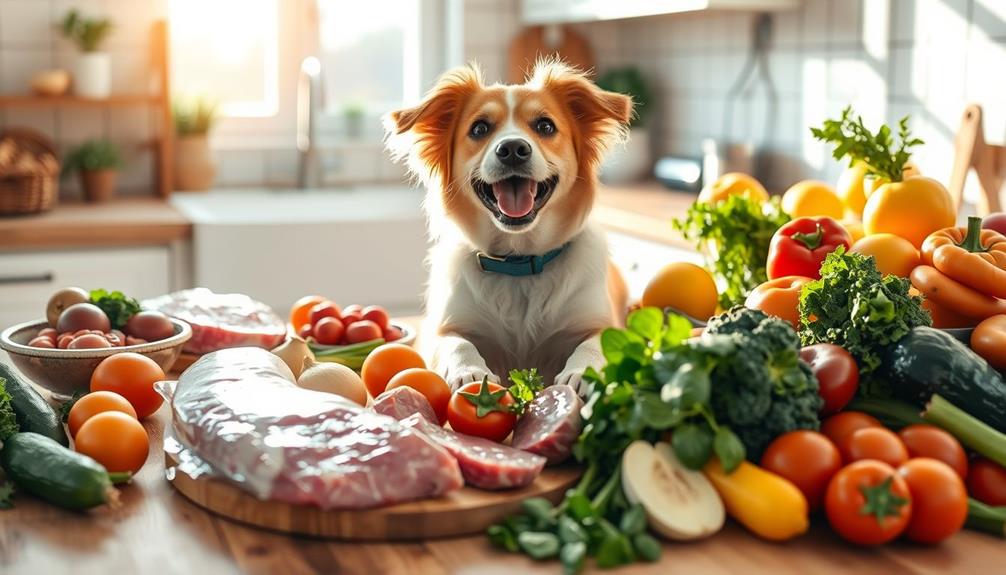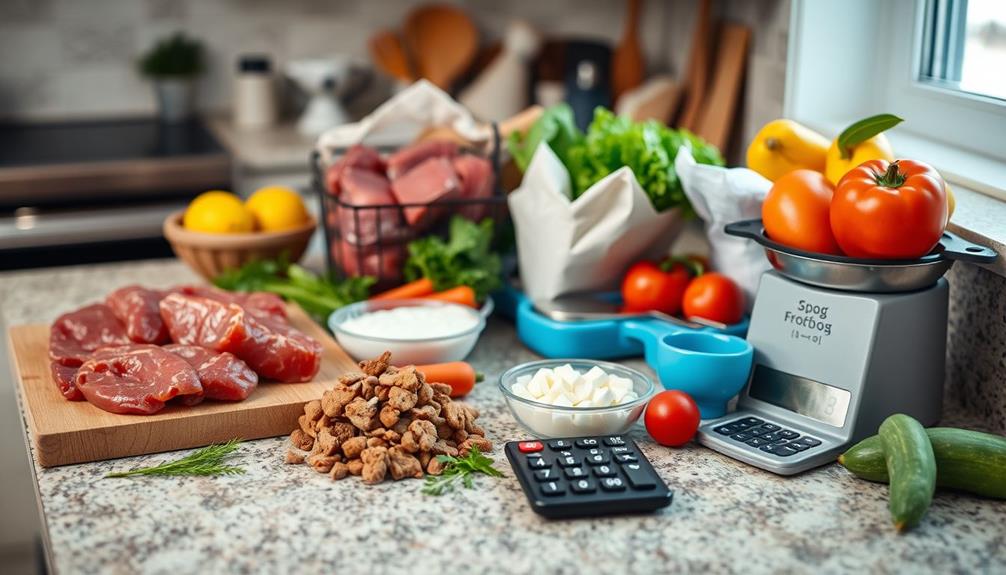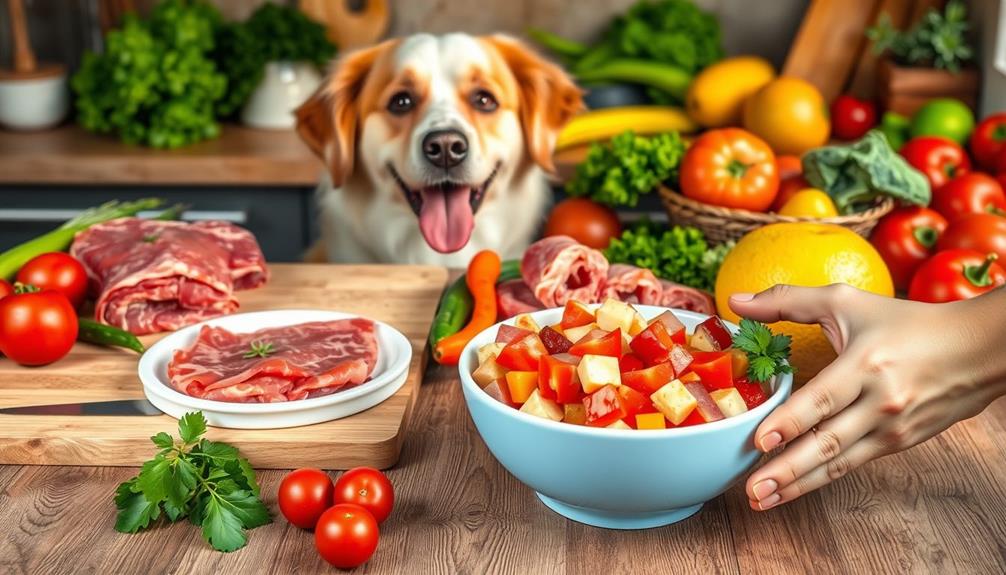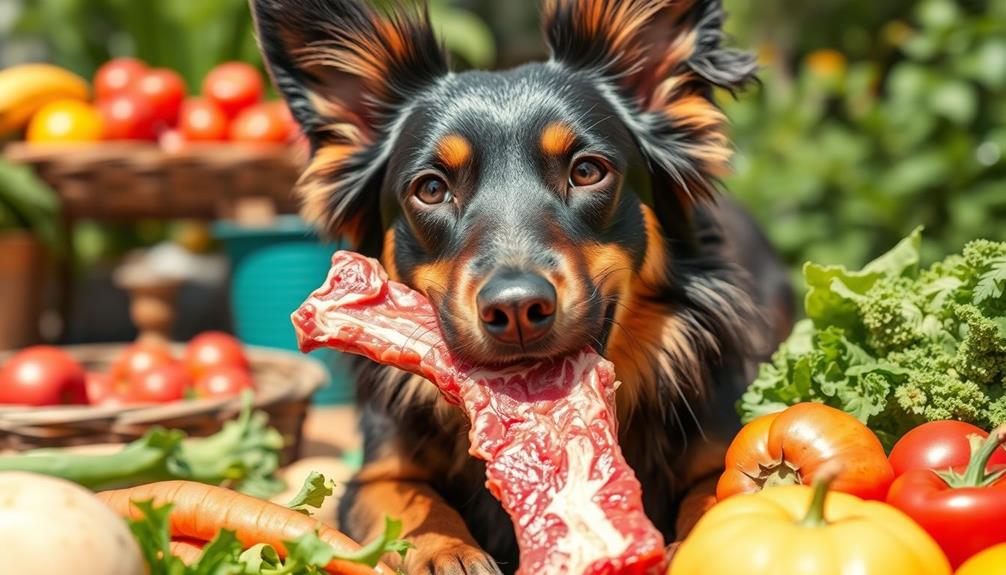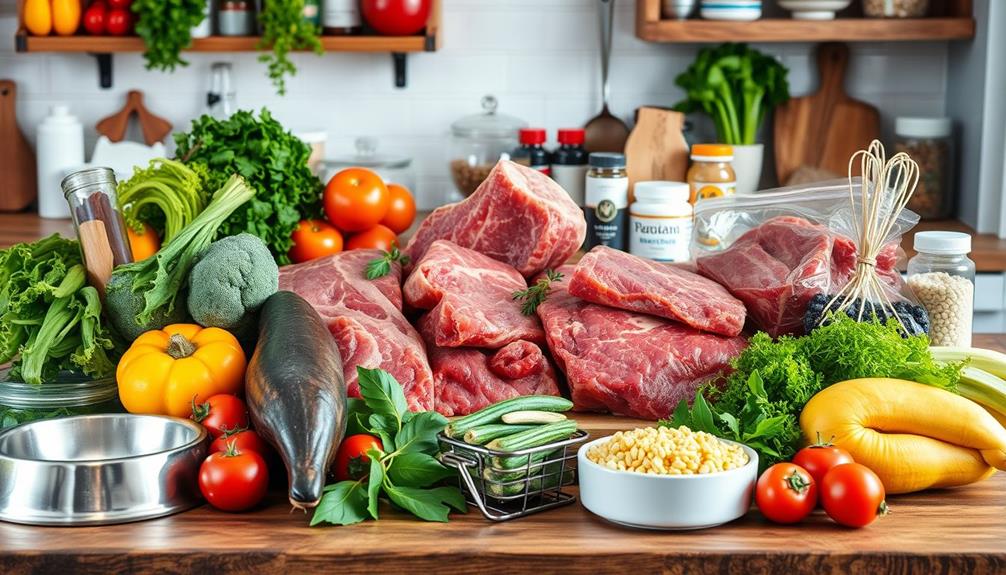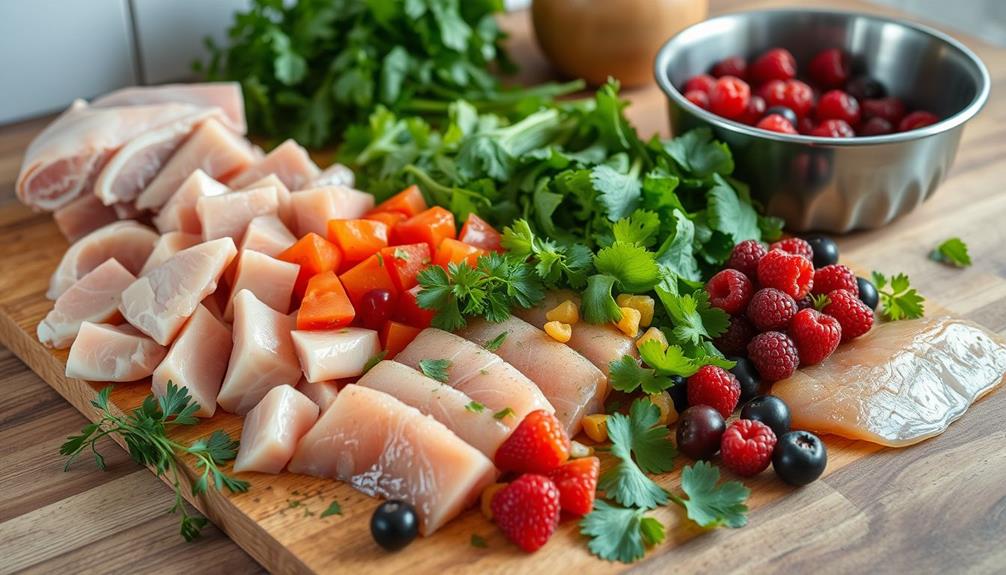Raw foods can be beneficial for your dog, offering potential improvements in coat health, energy levels, and digestion. However, they also carry risks, such as bacterial contamination and nutritional imbalances. It's vital to consult with a veterinary nutritionist to guarantee a balanced diet and minimize health risks. You'll need to handle raw food safely to protect both your pet and yourself from harmful pathogens. While many owners report positive changes, it's important to take into account your dog's specific needs and health conditions. There's much more to explore about raw diets and how they can fit into your dog's nutrition plan. Some dogs may also have difficulty adjusting to raw dog food and odors, and it’s important to monitor your pet’s response to the new diet. Some may experience gastrointestinal upset or intolerance to certain ingredients. It’s essential to be patient and observant during the transition process, and make adjustments as needed to ensure your dog’s well-being.
Key Takeaways
- Raw dog food can improve skin health and energy levels due to higher protein and essential fatty acids.
- Risks include bacterial contamination, with 25% of samples testing positive for pathogens like Salmonella and Listeria.
- Nutritional imbalances can occur without careful planning, leading to deficiencies in essential nutrients.
- Consult a veterinary nutritionist to ensure balanced and safe raw food diets for your dog.
- Proper hygiene and safe handling practices are vital to mitigate health risks associated with raw feeding.
Overview of Raw Dog Food
Raw dog food, often referred to as the BARF diet, aims to replicate the natural eating habits of wild canines. This diet typically consists of raw meat, bones, fruits, and vegetables, focusing on high protein content and low carbohydrate levels.
While some dog owners believe that raw dog food leads to health benefits like shinier coats, improved dental health, and increased energy levels, proper diet considerations are vital to guarantee your dog's health. Veterinary advice is essential when considering this dog's diet.
The CDC and FDA warn against raw diets due to the risk of bacterial contamination, with about 25% of raw food samples testing positive for harmful bacteria such as Salmonella and Listeria. Additionally, nutritional deficiencies can arise if the diet isn't carefully balanced. To avoid these issues, it's advisable to consult with a veterinary nutritionist to make sure that your dog receives all necessary macro- and micro-nutrients.
While commercial raw options may seem convenient, they still carry similar risks. If you're thinking about changing to raw ingredients, thorough research and professional guidance can help navigate the potential pitfalls of the BARF diet.
Potential Benefits of Raw Diets
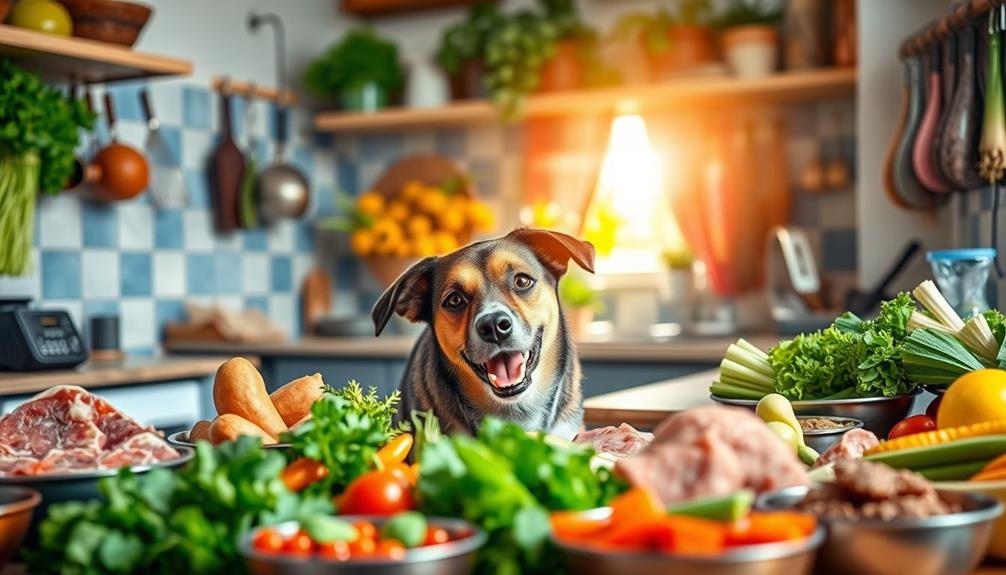
Switching to a raw diet for your dog might lead to improved skin health and a shinier coat, thanks to the higher protein and fat content.
Additionally, incorporating nutrient-rich foods can support your dog's overall health and well-being, similar to how cranberry juice consumption is linked to antioxidant benefits for humans.
You may also notice enhanced energy levels, as raw foods are packed with nutrients that can invigorate your pup.
These benefits make a compelling case for considering a raw diet as part of your dog's nutrition plan.
Improved Skin Health
Many dog owners have noticed significant improvements in their pets' skin health after switching to a raw food diet. Advocates claim that the high protein content and essential fatty acids found in raw meats can promote healthier skin and contribute to a shinier coat.
Raw food diets are often lower in carbohydrates, which may help reduce the risk of skin allergies and sensitivities in some dogs. Additionally, the nutritional benefits of raw foods may also align with the importance of selecting the right dietary components for overall health natural remedies alongside conventional medications.
The omega-3 fatty acids present in raw diets, especially from sources like fish and flaxseed, support skin health and help reduce inflammation. Many pet owners report a decrease in skin conditions, such as dryness and irritation, after shifting their dogs to a raw food diet.
This improvement can be attributed to the nutritional components in these diets, including vitamins A and E, which play a vital role in maintaining skin integrity and overall health.
Enhanced Energy Levels
Dogs often show increased energy levels after adopting a raw food diet, and this boost can be linked to the higher protein content and nutrient density found in these meals. Raw diets typically include fresh, whole ingredients that not only enhance digestion but also improve nutrient absorption. This can lead to greater liveliness and stamina, especially in active dogs.
Many proponents argue that an ancestral diet—mimicking the natural eating habits of wild canines—fosters improved energy levels and overall wellness. You might notice that dogs on raw diets exhibit reduced lethargy and engage more in physical activities.
Here's a quick comparison of raw food benefits:
| Aspect | Raw Food Diet |
|---|---|
| Protein Content | Higher than kibble |
| Nutrient Density | Rich in essential nutrients |
| Digestion | Improved |
| Energy Levels | Increased |
| Overall Wellness | Enhanced |
Switching to a raw food diet may just be the boost your dog needs. With increased energy levels, your furry friend could become more playful and engaged, making playtime even more enjoyable!
Risks and Health Concerns
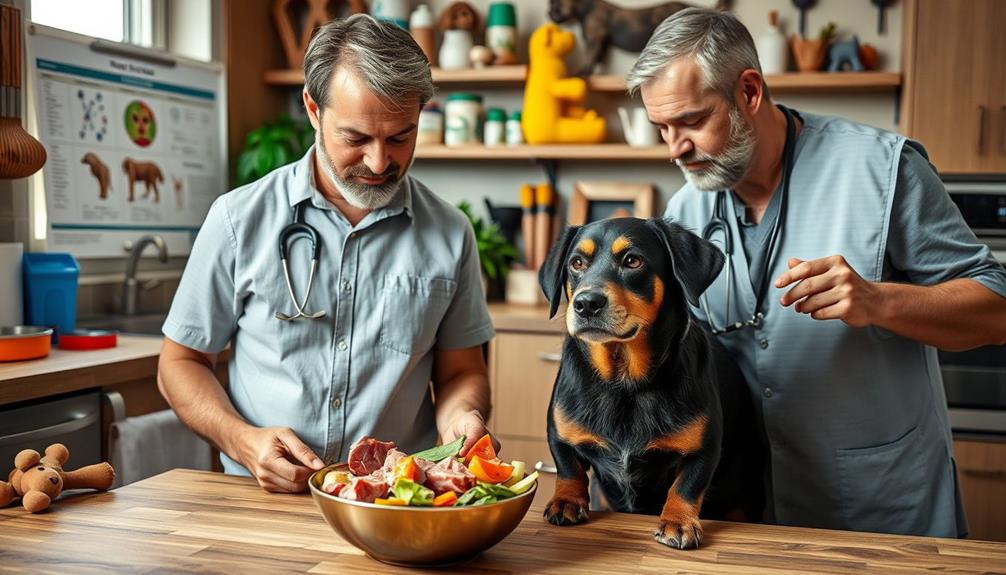
When considering a raw food diet for your dog, it's essential to be aware of the risks involved.
Bacterial contamination is a significant concern, with harmful pathogens like Salmonella potentially affecting both your pet and your family.
Mammography aims to detect early health issues, highlighting the importance of preventive measures.
Additionally, an unbalanced raw diet can lead to nutritional deficiencies that may harm your dog's health in the long run.
Bacterial Contamination Risks
Raw food diets for dogs can pose significant bacterial contamination risks that not only affect canine health but also endanger humans handling the food. Approximately 25% of raw food samples test positive for harmful bacteria like Salmonella and Listeria monocytogenes.
Additionally, maintaining a clean environment is vital for pet owners, as air purification techniques can help reduce airborne pathogens in the home.
Here are three key health risks to take into account:
- Transmission of Salmonella: With over 1.2 million cases of salmonellosis in the U.S. annually, dogs can be asymptomatic carriers, increasing the risk of transmission to their owners.
- Listeriosis Threat: Dogs can carry Listeria monocytogenes without showing any signs of illness, and this bacterium is responsible for about 1,600 cases and 260 deaths each year in the U.S.
- Vulnerability of High-Risk Groups: Children, the elderly, pregnant women, and those with weakened immune systems are especially susceptible to severe illness from bacterial contamination associated with raw dog food.
To mitigate these health risks, proper hygiene practices, such as thorough handwashing and disinfecting surfaces after handling raw food, are essential.
However, the safest option is to avoid raw diets altogether.
Nutritional Imbalance Issues
While many pet owners are drawn to raw food diets for their perceived health benefits, these diets can often lead to significant nutritional imbalances. Without careful planning, your dog might miss essential macro- and micro-nutrients, leading to various health issues over time. Unbalanced raw diets may not meet the Association of American Feed Control Officials (AAFCO) nutrient profiles, raising concerns about their adequacy for long-term feeding.
| Potential Issues | Nutritional Deficiencies | Recommended Action |
|---|---|---|
| Bone deformities | Calcium and phosphorus | Consult a vet nutritionist |
| Muscle wasting | Protein deficiencies | Guarantee a balanced diet |
| Poor coat condition | Essential fatty acids | Review diet regularly |
These deficiencies can manifest as serious health issues, including bone deformities in growing puppies. Dogs fed these diets may experience muscle wasting or poor coat condition due to insufficient protein or essential fatty acids. As a result, it's vital to consult a vet nutritionist to guarantee your dog's raw food diet is balanced and suitable for their specific health needs. Prioritizing a well-rounded diet is important for maintaining your dog's health.
Safety Handling Raw Foods
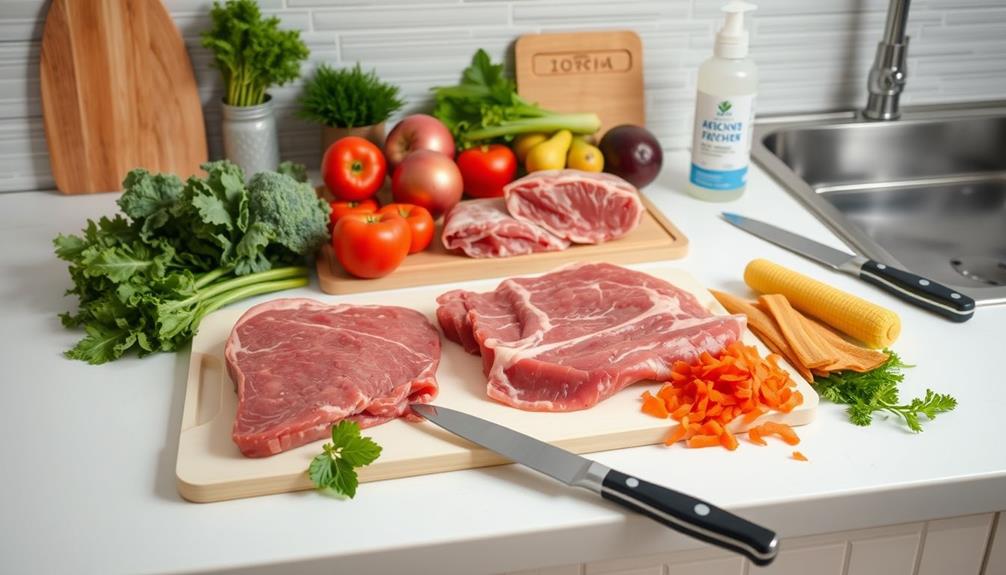
Handling raw foods for dogs requires diligence and care to guarantee the safety of both your pet and yourself. The risks associated with raw food, particularly harmful bacteria like Salmonella and Listeria, are significant.
Additionally, confirming your dog's overall health can be supported by incorporating essential oils, such as eucalyptus oil for respiratory health, into their care routine.
Here are three essential safety tips for handling raw food:
- Wash Hands: Always wash your hands with soap and water after handling raw food. This helps eliminate bacteria from your skin.
- Clean and Disinfect: Make sure to clean and disinfect all surfaces and utensils that come into contact with raw food. This prevents cross-contamination with other foods.
- Proper Thawing: Thaw raw food in the refrigerator or microwave rather than at room temperature to minimize bacterial growth.
Storing raw food in the freezer until you need it is vital for food safety. Use separate dishes and cutting boards for raw food to avoid spreading bacteria.
Don't forget to promptly refrigerate any leftovers to limit bacterial proliferation. By following these guidelines, you'll not only protect your pet but also guarantee a clean and safe environment for yourself and your family.
Nutritional Needs and Veterinary Advice
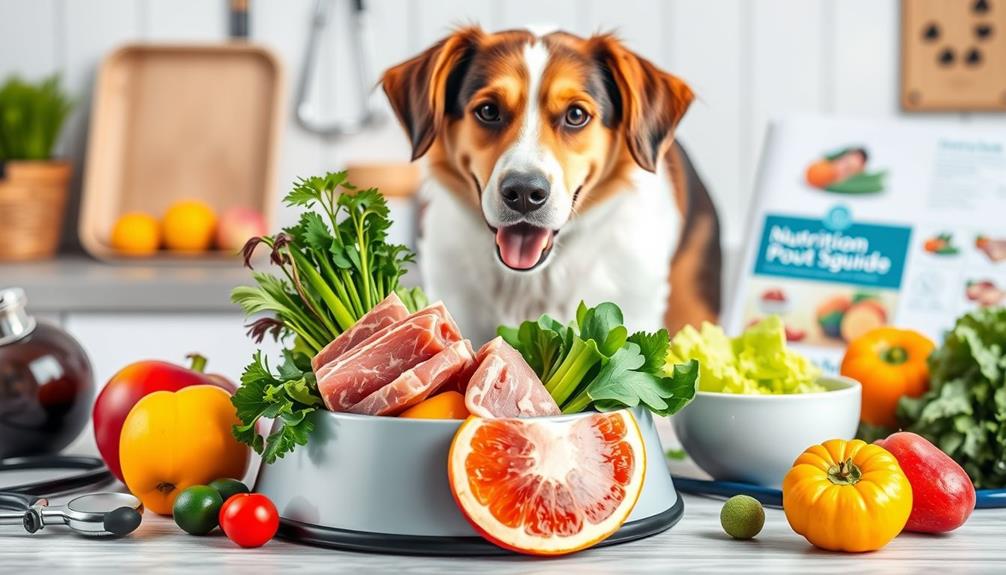
Guaranteeing your dog gets the right nutrition is essential for their health and well-being. Raw food diets can often lack balanced macro- and micro-nutrients, making it critical to consult a veterinary nutritionist for proper planning. Many raw diets fail to meet the AAFCO nutrient profiles necessary for ideal canine health, as emphasized by the American Animal Hospital Association and the FDA.
Veterinary professionals frequently recommend commercially prepared dog food, as these products undergo rigorous testing to guarantee balanced nutrition and safety. Specific health conditions, like kidney failure or pancreatitis, can be exacerbated by raw diets, underscoring the significance of tailored dietary advice from your veterinarian.
Regular veterinary check-ups are fundamental for monitoring your dog's dietary changes, guaranteeing they receive the right nutrition, and addressing potential health issues early.
Here's a quick overview:
| Dietary Option | Benefits | Considerations |
|---|---|---|
| Raw Food Diets | Natural ingredients | May lack balance |
| Commercially Prepared Food | Meets AAFCO standards | Potential additives |
| Veterinary Recommended Diet | Tailored to individual needs | Requires vet consultation |
| Regular Veterinary Check-ups | Ongoing health monitoring | Essential for all dogs |
Myths and Misconceptions
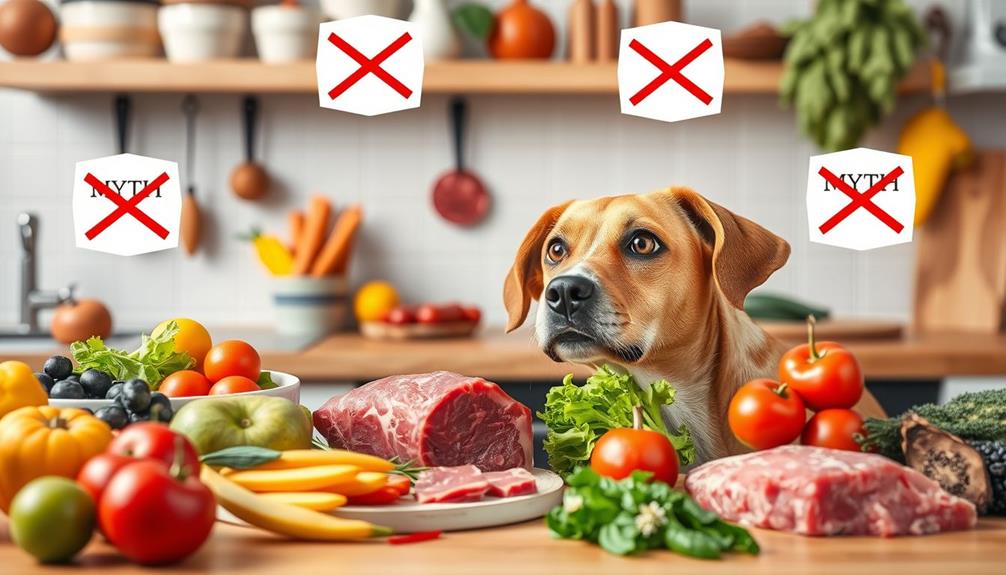
Many dog owners believe that raw food diets are the best option for their pets, often ignoring the potential risks and misconceptions surrounding these diets.
It's important to recognize that just as with elderly care, proper planning and understanding are vital for ensuring the health and well-being of your dog.
Here are three common myths you should be aware of:
1. Raw diets are nutritionally complete: Many assume these diets provide all essential nutrients, but they often lack balanced macro- and micro-nutrients, leading to deficiencies that could harm your dog's health.
In fact, just like financial considerations for elderly care, nutritional balance is essential for long-term health.
2. Raw bones are safe for dogs: While some advocates claim that raw bones are a natural treat, they can pose serious health risks.
Choking, broken teeth, and internal injuries from bone fragments are frequent concerns that shouldn't be overlooked.
3. Raw diets suit all dogs: This is a dangerous misconception.
Certain health conditions, like kidney failure and pancreatitis, can be worsened by raw diets. Always seek a veterinary consultation before making significant dietary changes.
General Health Considerations for Dogs
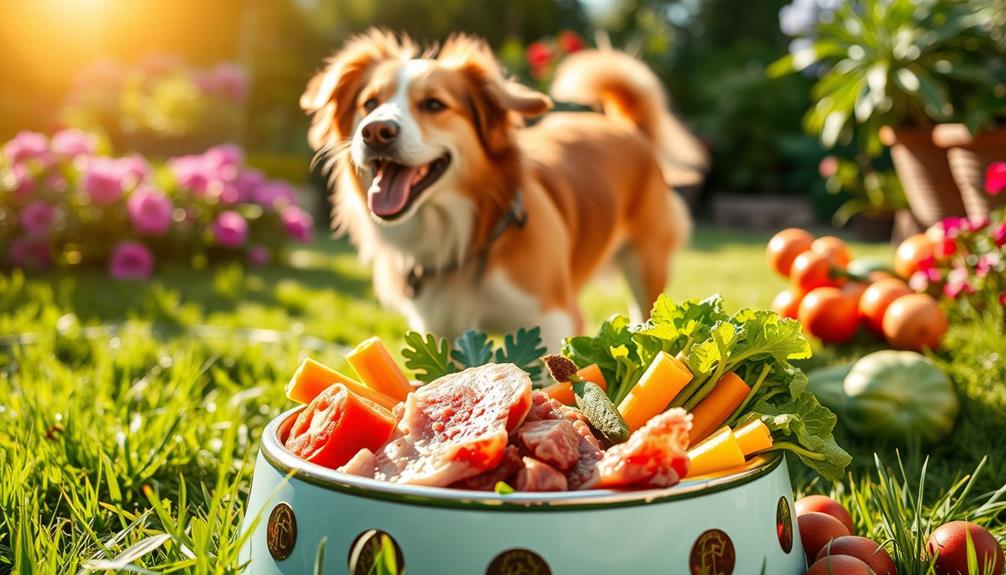
Your dog's health hinges on a combination of regular veterinary care, proper vaccinations, and consistent dental hygiene. Regular vet check-ups are essential for early detection of health problems, allowing you to monitor their overall wellness and catch issues before they become serious health concerns.
Additionally, understanding the key domains of development in psychology, such as how environmental interactions affect behavior, can help you recognize changes in your dog's health and habits environmental interactions shape development. Vaccinations protect your dog from severe illnesses like rabies and parvovirus, so keeping them up to date is imperative.
Dental care is often overlooked but is critical. About 80% of dogs will experience periodontal disease by age three, leading to pain and other complications if untreated. Maintaining oral hygiene can prevent these issues.
Weight management is another key aspect of your dog's health. Obesity can increase the risk of chronic conditions, such as diabetes and joint problems, making it essential to feed a balanced diet—considering the benefits of a raw diet—and regulate portions.
Lastly, regular physical activity, ideally at least 30 minutes daily, helps maintain a healthy weight and boosts overall longevity. Each of these factors plays a significant role in ensuring your dog thrives, whether you choose to introduce raw food to dogs or stick to traditional diets.
Frequently Asked Questions
Is Raw Food Actually Better for Dogs?
You might think raw food is better for dogs, but it often lacks essential nutrients and carries health risks. It's vital to weigh the potential benefits against the documented hazards before making any dietary changes.
What Are the Disadvantages of Raw Food for Dogs?
Raw food diets can pose serious health risks for your dog. You might face bacterial contamination, nutritional imbalances, choking hazards from bones, and increased preparation time, making them potentially unsafe and less convenient than traditional options.
Do Vets Recommend a Raw Diet for Dogs?
When it comes to feeding your dog, vets often don't beat around the bush: they generally don't recommend raw diets. They emphasize safety and balanced nutrition, urging you to choose commercially prepared food instead.
How Do I Know What Raw Food to Feed My Dog?
To choose the right raw food for your dog, guarantee it's balanced and high-quality. Consult a vet, introduce new foods gradually, and monitor for any gastrointestinal issues during the changeover to prevent digestive upset.
Conclusion
In the garden of dog nutrition, raw foods can be a vibrant flower, full of potential benefits. However, just like a blooming flower needs care, so does a raw diet require caution and knowledge. By understanding the risks and seeking veterinary advice, you can cultivate a healthy path for your furry friend. Ultimately, striking the right balance will help your dog thrive, turning the garden of their health into a flourishing paradise.

